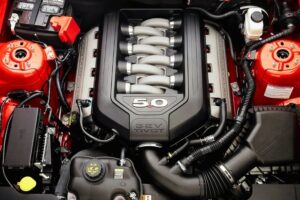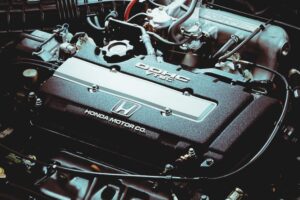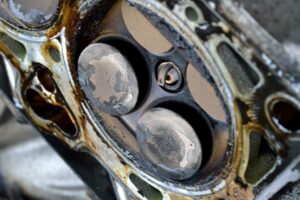DMAX Ltd is a joint venture between Isuzu Motors Ltd. and General Motors. Their first engine in the Duramax 6600 family was the 6.6L Duramax LB7 (2001-2004). So, what are the main specs and features of the 2003 LB7 Duramax?
The LB7 Duramax diesel engine is a four-valve-per-cylinder, direct-injected, turbocharged, intercooler V-8 engine first released in 2001 and then upgraded in 2003 and 2004. It produces 300 horsepower and 560 lb-ft of torque. The 6.6L Duramax is the world’s fastest diesel development program to date, having started with a blank sheet of paper.
Read more about the 2003 LB7 Duramax and its common problems.
2003 Duramax Specs

Power Output
The 6.6L Duramax LB7 diesel engine was produced in 2001 and improved in 2003 and 2004. It has a power output of 300 horsepower and 560 lb-ft of torque. This engine outperformed any diesel engine GM has ever supplied, including the aging 6.5L Detroit platform.
It is fair to say the debut of the Duramax LB7 was a watershed moment for GM in the diesel pickup and chassis cab markets in the United States. It took only 37 months, from design to early production.
This involved the development of a brand-new “greenfield” manufacturing plant in Moraine, Ohio.
The 600,000 square-foot facility houses four-machining lines, a heat-treat facility, and engine assembly. The plant can produce 105,000 engines per year at the moment.
Equipped with a Heavy-duty Allison 1000 Five-speed Automatic Transmission
To manage the new engine’s power, GM used a heavy-duty Allison 1000 five-speed automatic transmission, which proved to be a winning combination.
Available with a ZF six-speed Manual Transmission
The 2003 6.6L Duramax was also available with a ZF six-speed manual transmission, but the Allison 1000 was more popular then.
2003 Duramax Reliability
Had a Proprietary Common Rail Injection Technology
The 6.6L Duramax had a proprietary common rail injection technology that its closest competitors wouldn’t get until later. Ford, for instance, would not offer its first common rail until the 2008 model year.
Strikes a Balance of Fuel Economy and Great Performance
The LB7 engine strikes a balance of fuel economy and great performance.
Its layout gives considerable mid-range power without losing low-end torque, with a bore-to-stroke ratio of approximately one to one.
Problems with Fuel Injectors
It is not without flaws, though, as some problems arose later with the fuel injectors. Chevrolet discovered that the problem’s source was the fuel injectors’ position.
Injector failures became so widespread that GM had to initiate a recall and replace them with a new design, reassuring their loyal customers that they had solved the problem by extending the fuel injector warranty to 200,000 miles.
Replaced by the LLY
The LB7 would last until the middle of the 2004 model year when it was replaced by the LLY, a rebuilt Duramax diesel engine.
LB7 Duramax Overview
| Engine Family | 2003 Duramax diesel (Duramax 6600) 6.6L |
| Applications/Production Years | 2003 Chevy Silverado 2500 HD 2003 – 2004 GMC TopKick C4500, C500 2001 – 2004 GMC Sierra 2500, 3500 2003 – 2004 Chevrolet Kodiak C4500, C5500 |
| Displacement | 6.599 liters (6.6 liters nominal) |
| Configuration | 90 degree V-8 |
| Engine Block Material | Induction hardened and cast grey iron |
| Cylinder Head Material | Cast aluminum alloy |
| Minimum Cylinder Pressure | 300 psi |
| Engine Oil Capacity | 10 quarts with oil filter change |
| Engine Weight | Approx. 835 lbs |
| Injection System | Direct injection Bosch high-pressure common rail system CP3 injection pump 23,000 psi max injection pressure |
| Aspiration | Inter-cooled, turbocharged (charge air cooler, air to air intercooler) IHI RHG6 turbocharger |
| Reciprocating Assembly | Cast iron main bearing caps Fracture-split forged alloy Steel connecting rods Nitrided forged steel crankshaft Forged steel camshaft |
| Valvetrain | Mechanical roller lifters Overhead valve (OHV) Standard cam-in-block Four valves per cylinder (32 valves) |
| VIN Code | 1 (8th digit of VIN) |
| Assembly Site | DMAX engine plant, Moraine, Ohio |
| Compression Ratio | 17.5: 1 |
LB7 Duramax Size
Take up the Same Amount of Space as the Gasoline Engine
GM wanted to offer a diesel engine that could take up the same amount of space as the gasoline engine it was replacing, so they did.
They wanted to recognize this early in the development process because they knew that a diesel engine requires additional equipment, such as:
- Turbocharger,
- Injection pump, and
- Intercooler.
Contain Turbocharger, Fuel-injection Pump, and More
The LB7 engine’s architecture would contain the turbocharger, fuel-injection pump, and fuel rails, all of which are positioned in the valley of the cylinder block for a more compact size. The oil cooler is directly connected to the cylinder block’s left side.
Simplified Coolant Piping and Enhanced Engine Dependability
The coolant is transported to the left and right banks via a water tube in the flywheel housing. Stable temperatures on both sides simplified the coolant piping and enhanced engine dependability.
One serpentine belt would drive auxiliary equipment like the air conditioner compressor, power steering pump, and alternator. The accessory mounting brackets are situated on the front surface of the 2003 Chevy Duramax.
2003 LB7 Duramax Cylinder Heads

The four-valve cylinder head of the LB7 is built of gravity-cast aluminum for maximum efficiency and blowdown during the exhaust cycle. The fuel injector is located along the cylinder line’s center of the combustion chamber.
The manufacturer fitted the fuel injector into a stainless sleeve. Then, the sleeve is pressed into the cylinder head.
The valves are set up in a “twist” arrangement. Two independent intake ports promote tangential flow for optimal intake swirl.
The valve seats are adequately and evenly cooled so that they can minimize any changes in valve lash. The cooling property of aluminum does reduce heat deformation between the valve seats.
The temperature on the surface of the combustion chamber is lower because an aluminum cylinder head has a higher heat conductivity than a cast-iron one.
The lower temperature increases the valve seats’ durability and the engine’s overall reliability.
LB7 Engine Block
The cylinder block’s stiffness was an issue not only for endurance but also for noise reduction.
LB7’s engine block is made of a special grey iron alloy developed by Duramax.
The structure of the closed-type upper portion of the block is tailored for minimal deformation under the high combustion pressure of a diesel engine.
Duramax also wanted to make the engine’s lower part narrower. They also kept bore distortion to a minimum for the piston rings to remain sealed and avoid engine seizure. The six head bolts around each cylinder also help the gasket survive the tremendous in-cylinder pressure.
Again, is the LB7 Duramax a good engine? LB7 Duramax is a famous engine among diesel enthusiasts since it does not have emissions control parts. Overall, it is a reliable and robust engine.
LB7 Cooling System
The cooling system sends coolant to the back of the engine first, then around the cylinders, and back to the front. The coolant runs from the engine’s rear to the left and right of the cylinder block.
Coolant enters the thermostat housing after passing through the cylinders and the cylinder heads.
Also, Duramax uses dual thermostats with 180 and 185-degree opening temperatures. The water pump also sends coolant to the oil cooler, which is located on the left side of the cylinder block.
This improves the engine’s temperature management accuracy.
Main Features of the LB7’s Injection System
The design team of Duramax uses the following:
- Bosch common rail system with a high-pressure supply (CP3) pump,
- A function block, and
- A common-rail with a fuel injector for each cylinder.
This injection pump includes a gear-type feed and a rail pressure control valve.
Regardless of engine speed, this design can improve injection pressure.
This means the injector’s nozzle opening can be smaller, resulting in improved atomization and faster combustion when combined with the high working pressure. Duramax uses a pilot injection to reduce combustion noise and limit exhaust emissions.
LB7 Duramax Head Bolts
Each cylinder has six 14mm head bolts. The bore seal and the coolant seal get enough surface pressure from these head bolts.
Once you remove the engine, you can’t reuse the head bolts because they are torque-to-yield.
Duramax puts each bolt in what is described as the “plastic range” and tightens the bolt to the desired specification before twisting it to various degrees.
This eliminates the axial force that usually happens with a typical head bolt, resulting in effective sealing and minimal in-field service issues.
LB7 Duramax Pistons
The LB7 engine’s pistons are built of a high-silicon aluminum alloy.
To reduce noise, Duramax features a cast-in strut. Two compression rings and one oil control ring make up the three piston rings. The top ring has a barrel form.
The oil ring has a backup spring, and the second ring is undercut. To prevent ring groove wear, Duramax casts a ring carrier into the top ring groove.
Common 2003 Duramax Problems
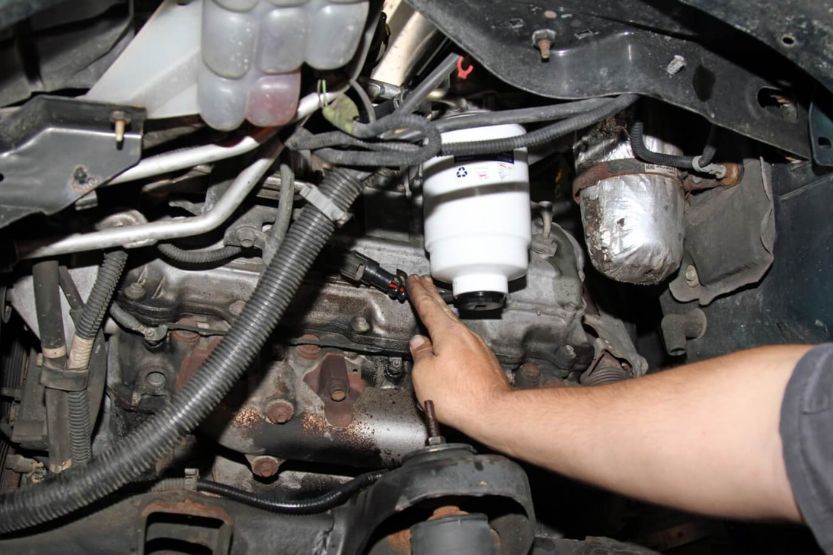
1. O-Ring Leaks in the Fuel Filter Housing
Leaking O-rings on the Fuel Filter Housing is one of the most typical LB7 Duramax issues. The original o-rings on these trucks may deteriorate over time as they age.
They’re also subject to the typical wear and tear. If you’ve had an LB7 Duramax for an extended period, you will run into this problem at some point.
A leaking o-ring not only lets air enter the system but also lets fuel leak. This causes many problems, such as sluggish starts and even engine faults.
2. Lack of Fuel Lift Pump
The 6.6L LB7 Duramax has a direct injection high-pressure common rail fuel system. This fuel injection system relies heavily on a CP3 fuel injection pump.
While the CP3 is dependable, it is also responsible for extracting gasoline from the tank and pressuring the fuel before it is given to the injectors.
The lack of a fuel lift pump puts the CP3 injection pump under additional strain. That said, problems with the actual pump, when used with stock applications, are quite rare.
However, when you add any tuning or other performance adjustments, the lack of a lift pump becomes apparent, and difficulties emerge.
3. Water Pumps Failures
The LB7 Duramax water pump, unlike the LBZ Duramax, is prone to leaking rather than outright failure. The OEM water pump has an iron impeller, which is far more durable than the plastic impellers found in recent models.
You will find that seals might deteriorate with time, which results in reduced coolant levels due to coolant loss. This can also lead to overheating.
Leaks can also cause a drop in pressure levels, resulting in insufficient coolant flow.
4. Overheating
Overheating is more likely in LB7 and LLY Duramax trucks than in later models. This is because they have a smaller radiator and fan than versions from 2006 or later.
A malfunctioning water pump or a damaged fan clutch are the most common causes of overheating. When the fan clutch fails, it stops the LB7 Duramax engine from receiving the additional cooling it requires.
Furthermore, a dirty or clogged radiator can also cause overheating. Your radiator can collect dirt, grime, and other substances over time. What is even more troubling is that the factory radiator is insufficient. So, you end up with a reduced surface area and, thus, a lower total cooling capacity.
5. Head Gasket Defect
The LB7 Duramax engine has a higher risk of head gasket failure than later Duramax engines. Despite this, head gasket failure rarely occurs until after 100,000 miles, making it far less prevalent than in 6.0L Powerstroke engines.
There are several reasons why LB7 Duramax head gasket problems can develop. For instance, something as simple as a raised cylinder head or just “tuning” can cause head gasket failure.
Also, the LB7 has a small radiator, fan, and faulty water pumps, all of which can cause head gasket failure.
Still, these are not the only reasons. The poorly constructed head gasket used on these trucks is also to blame. The head gasket on the LB7 Duramax is made of laminated steel.
It may elevate somewhat during the compression stroke. So, the steelhead gasket will potentially develop gaps over time, ending up with internal and external leaks.
6. Steering or Suspension Issues
The Duramax trucks’ independent front suspension is both a blessing and a disadvantage. It provides a more comfortable ride but is not as durable as a straight axle found on a Powerstroke or Cummins vehicle.
It might work on a stock vehicle, but we highly recommend improving the suspension and steering components if you plan on adding bigger tires, wheels, or a lift kit.
So, if you are pulling a lot of weight or doing any off-roading, these improvements will help a long way!
But, which steering and suspension components in the 6.6L LB7 Duramax create the most troubling issues? The most prevalent one is broken or snapped tie rods.
But, they are often caused by a worn or damaged pitman or idler arm. If you install a leveling kit or twist your torsion bars, your stock steering geometry will be thrown out of whack.
Moreover, this can cause control arm difficulties and early ball joint deterioration. So, upper control arm kits can be a lifesaver. They can extend the lifespan of your factory parts while also improving steering geometry.
7. High Horsepower
This is nothing to be concerned about if your vehicle is mainly stock. However, this is certainly something to consider if you have a high-performance truck.
Maintaining your truck in stock shape may be a good idea, as this will make it more reliable, especially if you decide to go for more horsepower and torque.
8. Allison Transmission
Diesel experts know that the Allison Transmission is one of the most dependable transmissions ever. There is a reason why GM has persisted with this transmission and is still using it in today’s L5P Duramax.
The first Allison was not nearly as muscular as later Allisons. The Allison 1000 transmission can enter limp mode if you tune your LB7 Duramax or make other performance adjustments. This happens so often that we had to include it in this list.
Limp mode on the Allison 1000 transmission is a failsafe device that prevents additional transmission damage.
When it detects sliding in the transmission, it enters limp mode, drastically reducing power. If you have a factory truck, you should not have any problems with your Allison transmission going into limp mode.
Conclusion – 2003 Duramax Review
The LB7 Duramax diesel engine has outperformed every diesel engine GM has ever produced, even the 6.5L Detroit platform, which is now obsolete. That’s not that bad, given that it was first produced in 2001 and then upgraded in 2003 and 2004.
The 6.6L Duramax is the world’s fastest diesel development program to date. It produces 300 horsepower and 560 pound-feet of torque. No wonder why the Chevrolet Silverado is a big fan.
Plus, the LB7 Duramax came with a patented common rail injection system that its closest competitors did not get until much later. Even Ford would not have this until 2008!
Read next:
Differences Between 2-Stroke and 4-Stroke Engines

![Duramax Years to Avoid [Worst Duramax Engines] duramax years to avoid](https://roadsumo.com/wp-content/uploads/2022/05/Duramax-years-to-avoid-150x150.jpg)
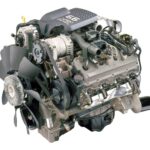
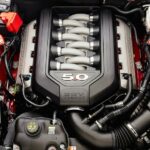
![Electric Parking Brake Problems [Causes and How to Fix] electric parking brake problems](https://roadsumo.com/wp-content/uploads/2022/05/electric-parking-brake-problems-150x150.jpg)
![5.7 Hemi Problems [7 Most Common] 5.7 Hemi Problems](https://roadsumo.com/wp-content/uploads/2021/11/5.7-Hemi-Problems-150x150.jpg)
![Ford 6.2 Engine Problems [5 Most Common and How to Fix] ford 6.2 engine problems](https://roadsumo.com/wp-content/uploads/2021/06/ford-6.2-engine-problems-150x150.jpg)
